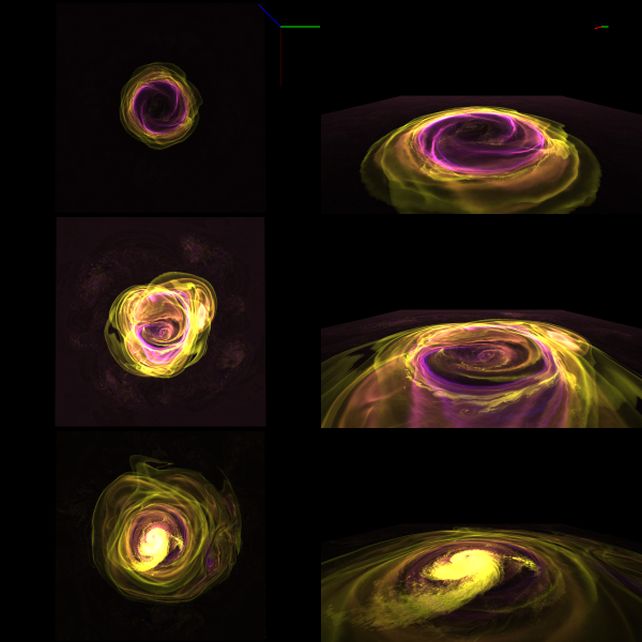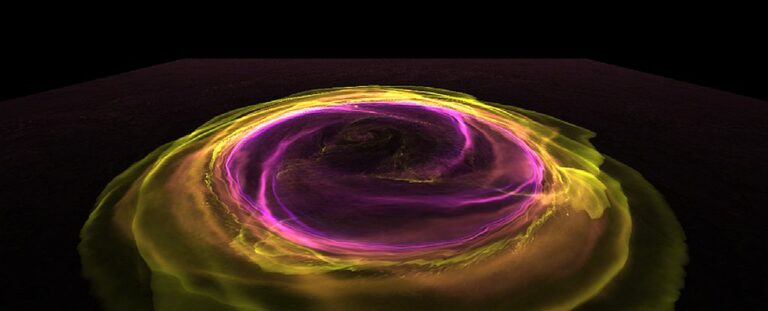Researchers triggered a thermonuclear blast within a high-performance computer.
Computer simulations are providing us with fresh perspectives on the tumultuous behavior of cannibal neutron stars.
When a neutron star engulfs material from a nearby binary companion, the unstable thermonuclear burning of the accumulated material can trigger a chaotic explosion that propels X-radiation throughout the cosmos. The exact evolution and spread of these powerful eruptions across the surface of a neutron star remain somewhat enigmatic. However, through attempts to recreate the observed X-ray flares using simulations, researchers are gaining insights into their intricacies – as well as the ultra-dense neutron stars responsible for their creation.
“We can observe these occurrences in greater detail through simulation,” stated computational astrophysicist Michael Zingale from the State University of New York at Stony Brook.
“One of our objectives is to comprehend the characteristics of the neutron star because we aim to understand how matter behaves under the extreme densities present in a neutron star.”
Neutron stars rank among the densest entities in the Universe. They represent the remnants of a massive star that has completed its life cycle, exhausted its fuel, and detonated in a supernova.
While the outer material disperses into space, the star’s core collapses due to gravity, forming an incredibly dense sphere approximately 20 kilometers (12 miles) in diameter, packing as much mass into that small space as up to 2.3 Suns.
Matter compressed to such extreme densities is anticipated to exhibit peculiar behavior, to say the least. Nevertheless, scientists can analyze their thermonuclear outbursts to establish limitations on their size, which can, in turn, aid in modeling their interiors.
Unfortunately, it is not feasible to approach a neutron star closely due to various factors such as distance and danger. However, we can gather as much information as possible about neutron star X-ray bursts and attempt to create a simulation that aligns with the data obtained through observations.

The concept may seem straightforward, but the study of neutron stars’ physics is actually quite complex; it necessitates a significant amount of computational power to accurately simulate their behavior.
In a previous study, the scientists utilized the Summit supercomputer at Oak Ridge National Laboratory to model the thermonuclear flames in two dimensions. They have now expanded upon this research by transitioning their simulations to a three-dimensional scale.
“Our primary objective is always to establish a connection between the simulations of these phenomena and the observations we have made,” Zingale elaborates. “Our aim is to gain insight into the structure of the underlying star, and exploring the capabilities of these models in multiple dimensions is crucial.”
The 3D model of the neutron star exhibited a temperature millions of times hotter than the Sun, with a rotational speed of 1,000 rotations per second, which is in close proximity to the theoretical maximum limit of neutron star rotation. Subsequently, they simulated the initial development of the thermonuclear flame.
While the flame in the 2D simulation propagated marginally faster than its 3D counterpart, the growth patterns in both models were remarkably similar. This consistency indicates that the 2D simulation remains an effective tool for investigating these explosive events, although there are certain limitations.
For instance, turbulence behaves differently in two and three dimensions; however, utilizing the 2D simulation for its strengths will free up computational resources for other tasks, such as enhancing the accuracy of the combustion process. Armed with this knowledge, the simulations can be leveraged to gain valuable insights into how neutron stars undergo their intense outbursts.
“We are on the verge of modeling the spread of the flame across the entire star, from pole to pole,” Zingale remarks. “It is truly an exciting prospect.”
The research has been published in The Astrophysical Journal.
Do not forget to share your opinion with us to provide you with the best posts !




0 Comments